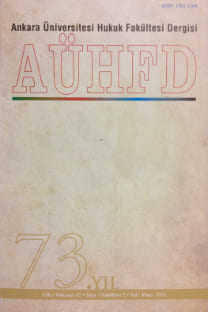AVRUPA İNSAN HAKLARI MAHKEMESİ İÇTİHADINDA TOPLANTI VE GÖSTERİ YÜRÜYÜŞÜ HAKKI
Toplantı ve gösteri yürüyüşü hakkının çoğulcu bir demokrasideki önemine gün geçtikçe daha fazla vurgu yapan AİHM, bu hakkı, ifade özgürlüğü ile alakalı ilkelerin de ışığında, git gide daha geniş bir yoruma tabi tutmaktadır. Toplantı ve gösteri yürüyüşü konusundaki Türk iç hukuk düzenlemeleri genel olarak AİHM’nin ortaya koymuş olduğu standartlara uygun olsa da, asıl sorun bu hükümlerde ortaya konulan ilkelerin pratiğe geçirilmesinde yaşanmaktadır. Bildirim şartının yerine getirilmemesinden dolayı yasa dışı sayılan, ancak barışçıl şekilde yapılan gösterilere kolluğun kuvvet kullanarak müdahelesi, veya kolluk tarafından kullanılan kuvvetin orantısızca sert oluşu, Türk davalarında çıkan ihlal kararlarının başlıca sebebini oluşturmaktadır. Bu bakımdan, AİHM standartlarının yargı organları tarafından iç hukukumuzda yaşama geçirilmesi, hem Türkiye’nin uluslararası hukuktan kaynaklanan bir yükümlülüğü, hem de Anayasa’nın 90. maddesinin bir gerekliliğidir
Anahtar Kelimeler:
Toplantı ve gösteri yürüyüşü hakkı, Avrupa
Right to Freedom of Assembly Under the Case Law of European Court of Human Rights
The European Court of Human Rights puts an increasing emphasis on the significance of the right to freedom of assembly in a pluralistic democracy and adopts an ever-expanding interpretation of this right, in the light of the parallel developments observed in the area of freedom of expression. Although the Turkish domestic laws on freedom of assembly appear to be in compliance with the standards laid down by the European Court of Human Rights in general, the application of these legal norms in practice has proved to be more problematic. The forceful intervention of the security forces targeting peaceful public demonstrations that are nevertheless deemed illegal for non-compliance with the notification condition, or the use of disproportionate force by the security forces in such circumstances, are the primary reasons underlying the violations found against Turkey. In this connection, the due implementation of the Strasbourg standards in domestic law and practice is a duty of the Turkish State not only out of respect for its public international law obligations, but also by virtue of Article 90 of the Constitution
Keywords:
Right to freedom of assembly, Article 11 of the,
___
- D. J. Harris, M. O’Boyle, C. Warbrick, Law of the European Convention on Human Rights, éd. Butterworths, London, Dublin, Edinburgh, 1995.
- D. J. Harris, M. O’Boyle, E.P. Bates, C.M. Buckley, Law of the European Convention on Human Rights, Oxford university Press, 2009.
- Györfi Tamás, The importance of Freedom of Assembly : Three models of Justification, in Free to protest, constituent power and street demonstration, edited by András Sajó, Eleven International Publishing, 2009.
- Mead David, The right to Peaceful Protest under the European Convention on Human Rights-A content study of Strasbourg Case Law, European Human Rights Law Review, issue 4 (2007), sf. 345 vd.
- Mead David, Strasbourg discovers the Right to Counter-Demonstrate: A Note on Öllinger v Austria, European Human Rights Law Review, issue 4 (2007), sf. 133 vd.
- Raymond Jean, La Liberté de Manifester selon la Convention européenne des droits de l’Homme, Revue trimestrielle des droits de l’Homme, année 1er, n° 4, 1990, sf. 332 vd.
- Salát Orsolya, New trends in the Assembly and Protest Jurisprudence of the European Court of Human Rights, in Free to protest, constituent power and street demonstration, edited by András Sajó, Eleven International Publishing, 2009, sf. 109.
- de Salvia Michele, Compendium de la CEDH, Les principes directeurs de la jurisprudence relative à la Convention européenne des droits de l’Homme, Vol. 1 – Jurisprudence 1960 à 2002, éd. N.P. Engel, Kehl, Strasbourg, Arlington, Va., 2003.
- Tanyar Ziya Çağa, AİHM kararlarında sendikal hakların gelişimi, Güncel Hukuk, Şubat 2010.
- ISSN: 1301-1308
- Yayın Aralığı: Yılda 4 Sayı
- Başlangıç: 1943
- Yayıncı: Ankara Üniversitesi Hukuk Fakültesi
